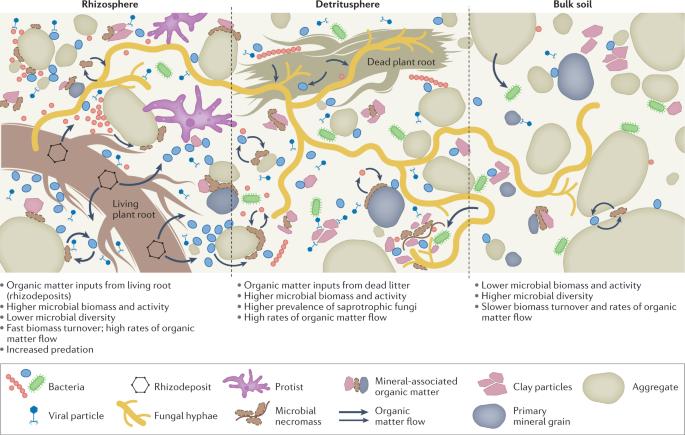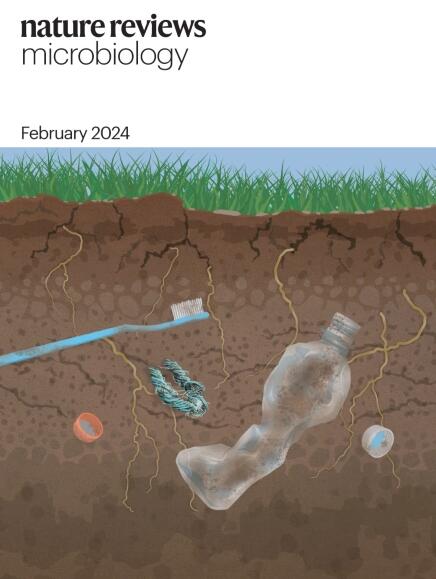Life and death in the soil microbiome: how ecological processes influence biogeochemistry
IF 103.3
1区 生物学
Q1 MICROBIOLOGY
引用次数: 195
Abstract
Soil microorganisms shape global element cycles in life and death. Living soil microorganisms are a major engine of terrestrial biogeochemistry, driving the turnover of soil organic matter — Earth’s largest terrestrial carbon pool and the primary source of plant nutrients. Their metabolic functions are influenced by ecological interactions with other soil microbial populations, soil fauna and plants, and the surrounding soil environment. Remnants of dead microbial cells serve as fuel for these biogeochemical engines because their chemical constituents persist as soil organic matter. This non-living microbial biomass accretes over time in soil, forming one of the largest pools of organic matter on the planet. In this Review, we discuss how the biogeochemical cycling of organic matter depends on both living and dead soil microorganisms, their functional traits, and their interactions with the soil matrix and other organisms. With recent omics advances, many of the traits that frame microbial population dynamics and their ecophysiological adaptations can be deciphered directly from assembled genomes or patterns of gene or protein expression. Thus, it is now possible to leverage a trait-based understanding of microbial life and death within improved biogeochemical models and to better predict ecosystem functioning under new climate regimes. Soil microorganisms shape global element cycles in life and death. In this Review, Sokol and colleagues explore how the biogeochemical cycling of organic matter depends on both living and dead soil microorganisms, their functional traits, and their interactions with the soil matrix and other organisms. They also discuss incorporating microbial life and death into trait-based models that predict soil biogeochemical dynamics.

土壤微生物群的生与死:生态过程如何影响生物地球化学
土壤微生物影响着全球元素的生死循环。活的土壤微生物是陆地生物地球化学的主要动力,推动着土壤有机物质--地球上最大的陆地碳库和植物养分的主要来源--的更替。它们的新陈代谢功能受到与其他土壤微生物种群、土壤动物和植物以及周围土壤环境的生态相互作用的影响。死亡微生物细胞的残留物可作为这些生物地球化学引擎的燃料,因为它们的化学成分可作为土壤有机物持续存在。随着时间的推移,这些非生物微生物生物量在土壤中不断积累,形成了地球上最大的有机物库之一。在这篇综述中,我们将讨论有机物的生物地球化学循环如何依赖于活的和死的土壤微生物、它们的功能特征以及它们与土壤基质和其他生物的相互作用。随着近年来全息技术的发展,许多决定微生物种群动态及其生态生理适应性的性状可以直接从组装的基因组或基因或蛋白质表达模式中解密。因此,现在有可能在改进的生物地球化学模型中利用基于性状的微生物生死理解,更好地预测新气候条件下的生态系统功能。土壤微生物影响着全球元素的生死循环。在这篇综述中,Sokol 及其同事探讨了有机物的生物地球化学循环如何依赖于活的和死的土壤微生物、它们的功能特征以及它们与土壤基质和其他生物的相互作用。他们还讨论了如何将微生物的生死纳入基于性状的模型,从而预测土壤生物地球化学动态。
本文章由计算机程序翻译,如有差异,请以英文原文为准。
求助全文
约1分钟内获得全文
求助全文
来源期刊

Nature Reviews Microbiology
生物-微生物学
CiteScore
74.00
自引率
0.50%
发文量
149
审稿时长
6-12 weeks
期刊介绍:
At Nature Reviews Microbiology, our goal is to become the leading source of reviews and commentaries for the scientific community we cater to. We are dedicated to publishing articles that are not only authoritative but also easily accessible, supplementing them with clear and concise figures, tables, and other visual aids. Our objective is to offer an unparalleled service to authors, referees, and readers, and we continuously strive to maximize the usefulness and impact of each article we publish. With a focus on Reviews, Perspectives, and Comments spanning the entire field of microbiology, our wide scope ensures that the work we feature reaches the widest possible audience.
 求助内容:
求助内容: 应助结果提醒方式:
应助结果提醒方式:


